Vintage Electric Bikes is known for their high-powered, high-speed, motorcycle inspired e-bikes. The founder, Andrew Davidge, has been widely recognized for his unique design approach and was even invited onto an episode of Jay Leno’s garage. Since 2013, his company has been refining and expanding their lineup, and in 2017 they launched the Cafe. It’s their first pedal assist only model, and it complies with the Class 3 definition of an electric bicycle in the United States; to be used on most public streets without a license or insurance. By comparison, their slightly more expensive Cruz and Tracker models do have throttles, can exceed 28 mph with the addition of a special off-road key and are classified as Class 2 throttle powered ebikes or a moped level off-road recreational product depending on how they are setup. The one thing they all have in common is a beautiful aesthetic. They are all powerful but operate super quiet and smooth, I was told that the motor controller uses a pure sine wave converter to make this possible and is even optimized for reduced cogging drag when powered on. The Cafe relies on a torque sensor to respond immediately to rider pedal input and balances fast acceleration against strong hydraulic disc brake action from Shimano. The front rotor is a larger 180 mm size and both levers are three-finger with adjustable reach to fit different hand sizes and accommodate gloves. The drivetrain on this bike offers ten gears for comfortable pedaling at a wide range of speeds and uses an upgraded derailleur with one-way clutch to keep the chain tight and reduce bounce and noise (just press the grey lever in the up position to activate it).
At just under $4k, The Vintage Electric Cafe it’s not the most affordable electric bike on the block, but it definitely isn’t the most expensive either, and it doesn’t skimp on quality or support. The company offers a two-year comprehensive warranty on all of their bikes and has backed that up with software updates and out-of-warranty upgrades on many of their earliest products. These bikes are almost like art to me, with premium leather touch points, high-end integrated lighting systems that match the other silver hardware parts, and a custom battery design. The battery pack is very unique and not only looks great but also keeps weight low and center on the frame for optimal balance, is easy to remove, and can still be secured to the bike if you’re leaving it parked at a public rack by removing a twist-in pin as shown in the video review above. There are a few trade-offs worth noting however, such as the mid-mounted kickstand that gets in the way of the left crank arm when rolling the bike around, minimal suspension, a bulky heavy battery charger, and the lack of bottle cage bosses… but Vintage Electric does sell a stylized rear rack for hauling cargo, the charger is faster than most others I have seen, and the two-inch Schwalbe tires combine with the Steel frame to reduce some vibration and jar at speed. This bike feels solid and comfortable on smooth terrain and none of the parts rattled around. I absolutely love the color-matched fenders and chain guard, the sturdy thru-axle, thicker spokes, and tapered head tube for strength and stability. The bike is available in three frame sizes and two beautiful color choices so friends and partners can enjoy it together… but the frames only come in high-step which might be a little tall for those with shorter inseams.
I was told that the Cafe model was inspired by vintage motorcycles, the cafe racer in particular, but I don’t really know much about classic motorcycles. Perhaps it’s mostly in the name because to me they look different, but it’s a cool theme to go with. The motor chosen for this bike is produced by TDCM and delivers 750 watts nominal with up to 70 Newton meters of torque. That’s a lot for an electric bike! Some of the most powerful and efficient mid-drive motors these days put out 60 Nm to 80 Nm and have a big mechanical advantage if you shift gears thoughtfully, so I went into the ride test a little skeptical. Once I gave it a try, especially in the highest Level 5 assist, I was blown away. They really got the sensors configured right to feel natural and the power is there. I found myself mostly riding in assist level 3 and still having a blast. The motor is a bit larger than geared designs and weighs a bit more at ~7 lbs vs. ~5 lbs or so, but it’s likely more durable because there aren’t moving parts inside, just magnets glued to the inside perimeter of the hub and electromagnetic staters in the center. One trade-off with this design is electromagnetic drag called cogging when the motor is not being powered. You can see the rear wheel spin down faster during part of the video review where I talk about cogging. I asked Andrew about this because the upside to cogging is power regeneration, but the Cafe does not have a regen button the way that some of the other models do. Perhaps a bit of electricity is recaptured but they really focused on reducing cogging by sending a small amount of power through to the motor whenever the bike is on so that it would not produce drag. In practice, it’s not a big issue, but I try to be fair and complete in my descriptions of these bikes and want to weigh the differences between each drive system type. This motor is powerful, sturdy, quiet, and won’t interfere with the chain, cassette and derailleur the way that mid-motors sometimes can.
Powering the bike is an above-average sized Lithium-ion battery pack. It offers 48 volts and 10.4 amp hours for just under half a kilowatt of juice. I was told that you can order a second pack for extended range but at 9.4 lbs and with such a unique form factor, I think I’d just bring the charger along if I needed to ride further. This battery sits low and center on the frame, it can be charged on or off the bike without any sorts of dongle adapters, and the leather handle on top is comfortable to use. The battery slides down onto a track and clicks in place. I didn’t hear it rattling at all during my rides and I love how the little pin locking mechanism works (and looks), it reminds me of a grenade or something. If you pull the pin out (or rather, twist it out) the battery cannot be taken off of the bike. This pin is small and light, it’d be easy to clip onto a keychain to take with you into work or a restaurant and most people probably wouldn’t even know how to remove the battery if you did leave it screwed in. My only complaint about the battery design has to do with the charging interface which is not magnetic like some of the other models and has a rubber cap which could easily be lost. I asked why they chose a non-magnetic charger connector (because that pulls out easily if tripped over and has always seemed like the nicest option to me) and was told that it slowly accumulates iron filings and gets dirty in garage environments. I was also told that their future chargers will be 5 Amp vs. the 6 Amp on show in the images and video, and that it would be slightly more compact and maybe a bit lighter too. So to reiterate, the Bosch Powerpack 500 battery that offers roughly the same capacity as the Vintage Cafe pack only weighs ~5.7 lbs and is physically smaller… but it doesn’t look as cool, probably isn’t as rugged, and is used on some competing products like the Electra Townie Commute Go! which weighs more than this bike overall. Interesting, right?
Operating this bike is intuitive and fast. Once the battery has been charged and is properly secured to the downtube, just hold the rubber M button near the top of the display panel. This turns it on and also allows you to cycle through menus. There are two more buttons below the display that allow you to arrow up for more power or down for less. You can even ride without any assist by using level zero, and this is handy for running the lights if you nearly deplete the pack or just want some exercise or slower riding. The display is pretty, just like the flick bell, silver bar, locking leather grips, and all of the rest of the hardware… but it is not removable. If you leave it out in the sun and rain, it should hold up pretty well, but it might get scratched or worn out over time at public bike racks. This is not uncommon, most ebike displays are not removable, much to my disappointment. But, just like the threaded motor connector, brake lines, and controller cable, it’s likely easy to replace and service. That’s because Vintage Electric did not route their cables and brake lines internally through the frame. This might have been a strength decision (the bike is rated at 300 lbs vs. most others at just 250 lbs) or maybe it was purely for accessibility and tuning access. Whatever the reason, I feel that the cables still stay out of the way and look good. I like that they rand them below the downtube vs. on the top tube. This is a bike that could easily hang from many car and public transport racks. You won’t snag the cables while riding or lifting the frame and that’s great.
In short, The Cafe electric bike is a thing of beauty. It rides well and blends in with non-electric bikes because the motor is painted black and the battery is part of the design. It stands out, but in a good way. I don’t mean to gush too much here, I’ve tried to be fair about the trade-offs (cost, high-step only, limited suspension) but it’s delightful to see something different and good in the space. It’s not just another decent affordable bike. It’s a reasonably priced beautiful bike with a unique drive system that performs above expectations. I love this thing to be honest, and I would probably keep it mostly as-is with the exception of a 27.2 mm silver Suntour NCX suspension post to ease my back and neck. I love riding fast but appreciate how stable this bike is with the wider tires. I love that the tires are lined with puncture protection to minimize flat fixes (especially because the rear wheel with the hub motor will take more time and effort to service. The front wheel has a quick release maxle and the rear rack is option but has two levels of mounting options. If you do go the way of swapping the seat post, just be careful with the power cable leading to the custom-integrated rear light. I think you might even have to unplug it if you swap the post (unless it has a hole at the top) and this is where the rear rack upgrade with a separate aftermarket light could come in handy. Vintage Electric sells through a network of dealers across the USA, has an beautiful factory store showroom in Santa Clara, California (near San Jose), and I believe they also sell online direct with a range of customization options. Big thanks to the Vintage Electric Bikes team for partnering with me on this review and having both colors on hand to film. We had a blast cruising around the city streets and a closed parking lot track for the video.
Pros:
- This is the first Vintage Electric bike model that’s being sold in three frame sizes, this allows riders to mount and pedal more comfortably… unlike some of their other ebikes, it does not have a throttle so optimal leg extension and comfort and ergonomics are more important
- The frame is made from chromoly Steel and can support up to 300 lbs vs. a lot of other electric bikes that max out around 250 lbs, Steel is often appreciated in the world of bicycles for being comfortable and offering vibration dampening qualities
- The wheels have 36 spokes for added strength (and the rear spokes are thicker 13 gauge), the head tube is tapered vs. straight, and both axles are thicker than average, the rear is 12 mm and the front is 15 mm with a Maxle style thru-axle (most bicycles use 9 mm skewers)
- Two gorgeous color choices, beautiful silver hardware, and matching leather grips, saddle, and battery handle make this one of the prettiest electric bikes I have tested, even the optional retro styled rear rack is something special and unique
- Safety is a big deal if you commute during peak hours and have to deal with dim mornings and dark evenings so I love that the Vintage Cafe has reflective tires and premium integrated lights from Supernova, they won’t get damaged or stolen as easily as aftermarket lights, nor will they run out of batteries and require more screwing around
- The fenders and chain cover are made from Aluminum which means they are sturdy, relatively quiet, and won’t rust but I also love how beautiful they are, both hardware components are paint matched to the frame, they will keep you clean in varied conditions which is important if you rely on the bike for commuting
- Given how sturdy the bike looks and feels, I was surprised that it only weighs about 56 lbs, many comparable e-bikes weigh near 60 lbs, it also stops well thanks to hydraulic disc brakes which have adjustable levers to make it easy for people with smaller hands or those wearing thick gloves
- The bike is well balanced front to rear, notice how low the battery box is on the frame vs. being built into a rear rack or even connected to the higher portion of the downtube
- Both the motor and battery are geared for power, the 48 volt pack sends higher amps and is more efficient than a 36 volt pack, the 750 watt nominal motor is rated at 70 Newton meters peak output which is incredible for a hub motor design… and it really does feel strong
- There’s no suspension fork or seat post suspension here stock but the dual-density saddle, padded grips, and high-volume tires feel good, at 28″ diameter, the wheels have a lower attack angle and coast very efficiently once up to speed, they even have Active Line K-Guard puncture protection to help reduce flats
- Great drivetrain, Shimano Deore XT with Shadow Plus one-way clutch to help tighten the chain and reduce bouncing, this derailleur setup is commonly found on mountain bike models but works well on speed pedelecs like the Vintage Cafe
- I noticed that the motor power cable is routed along the left side of the bike and doesn’t stick out very far where it might be snagged or bent, it’s a great design with a thicker gauge of wire and a threaded connector point to keep water and dust out, overall just more refined than a lot of other hub motor driven electric bicycles I have seen
- The battery pack is fairly easy to take off of the bike, it feels sturdy and I really appreciate the integrated handle because it does weigh ~10 lbs, it’s worth removing if you plan on lifting the bike up steps or storing it on a bike rack
- Pedal assist is activated through a torque sensor on this e-bike and to me it felt spot on, the power is delivered naturally so it ramps up smooth but it’s not at all weak, and the thing is just so quiet
Cons:
- The display panel looks beautiful, is easy to reach, and navigate while riding but it is not removable which could lead to scratches and weather-wear if parked regularly in public places or outdoors
- Gearless hub motors are revered for being reliable and quiet, this one is particularly powerful, but it does suffer from a touch of drag due to cogging (magnets repelling the stater when the bike is turned off and just coasting), it’s a minor gripe and at least Vintage has tried to minimize its affects when the bike is powered on
- Most of the other Vintage Electric models I have reviewed use the magnetic EnergyBus charger standard but the Cafe uses a pressure-fit plug that might not get as dirty but could get bent or caught if tripped over, just be careful with it and also keep an eye on the rubber charge port cover because it doesn’t have a leash or other connector to keep it with the bike and would be easy to lose
- Kickstands are important and the stock design here works well to balance the bike but because it’s positioned near the bottom bracket, it does get in the way of the left crank arm if you back the bike up with it in the down position
- The bike looks great, and I almost didn’t notice the wires at first, but they are tacked beneath the downtube vs. being internally routed through the frame, this is a minor aesthetic gripe and might make the frame stronger, cheaper, or easier to service
- Despite being built in three unique frame sizes, the standover height is pretty high because they are all cantilever high-step designs, the small is still around 31 inches which might be too high for petite riders or those with hip or knee sensitivity
- The battery charger is bulkier and heavier than average… this means it can be more of a hassle to lug around, but the upside is that it is very fast at 6 Amps vs. most others which just send 2 Amps, I was told that some future models will come with a more compact 5 Amp charger which sounds just right
- Some of the other electric bikes from Vintage have a regen button that acts as an engine brake and converts kinetic energy into electricity to slowly fill the battery but the Cafe does not have this
- Minor gripe but the bicycle frame does not have bottle cage bosses to add an accessory, you might have to get a disc brake compatible rack (or their official rack) and consider a handlebar cup holder adapter like this
- Minor gripe here but because the saddle has an integrated light, there’s a wire that comes up through the seat post and makes swapping the rigid Aluminum post out for a suspension post more difficult, just keep this in mind and be careful with the parts (disconnect the power cable leading the to seat light before pulling the seat post out), if you do purchase a seat post suspension, keep in mind it will raise the minimum saddle height by a few inches, the SR Suntour NCX is relatively short and comes in silver which would match beautifully
Resources:
- Official Site: https://vintageelectricbikes.com/
- More Pictures: https://goo.gl/photos/UNn4gkq9uszSp9T69

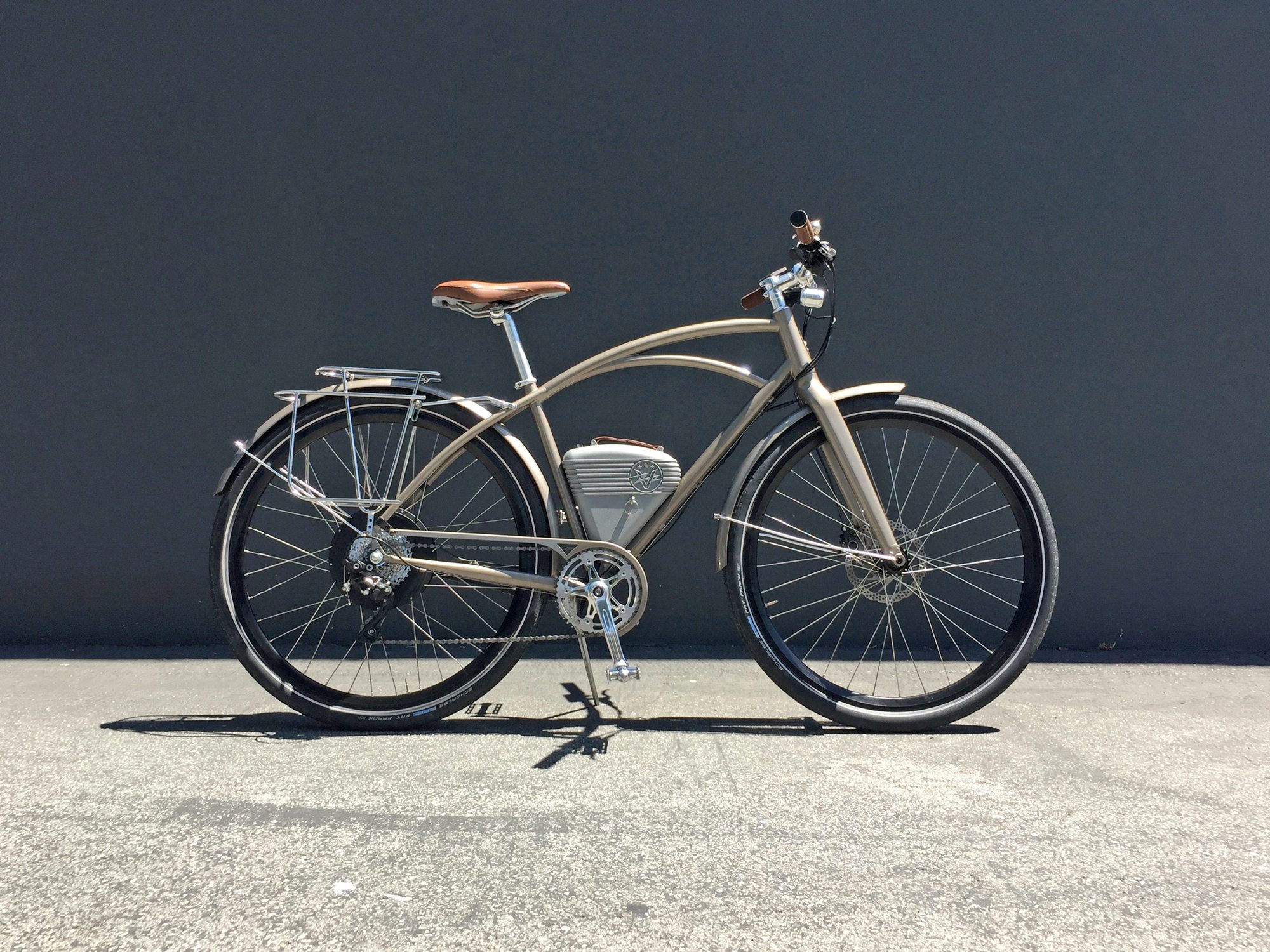
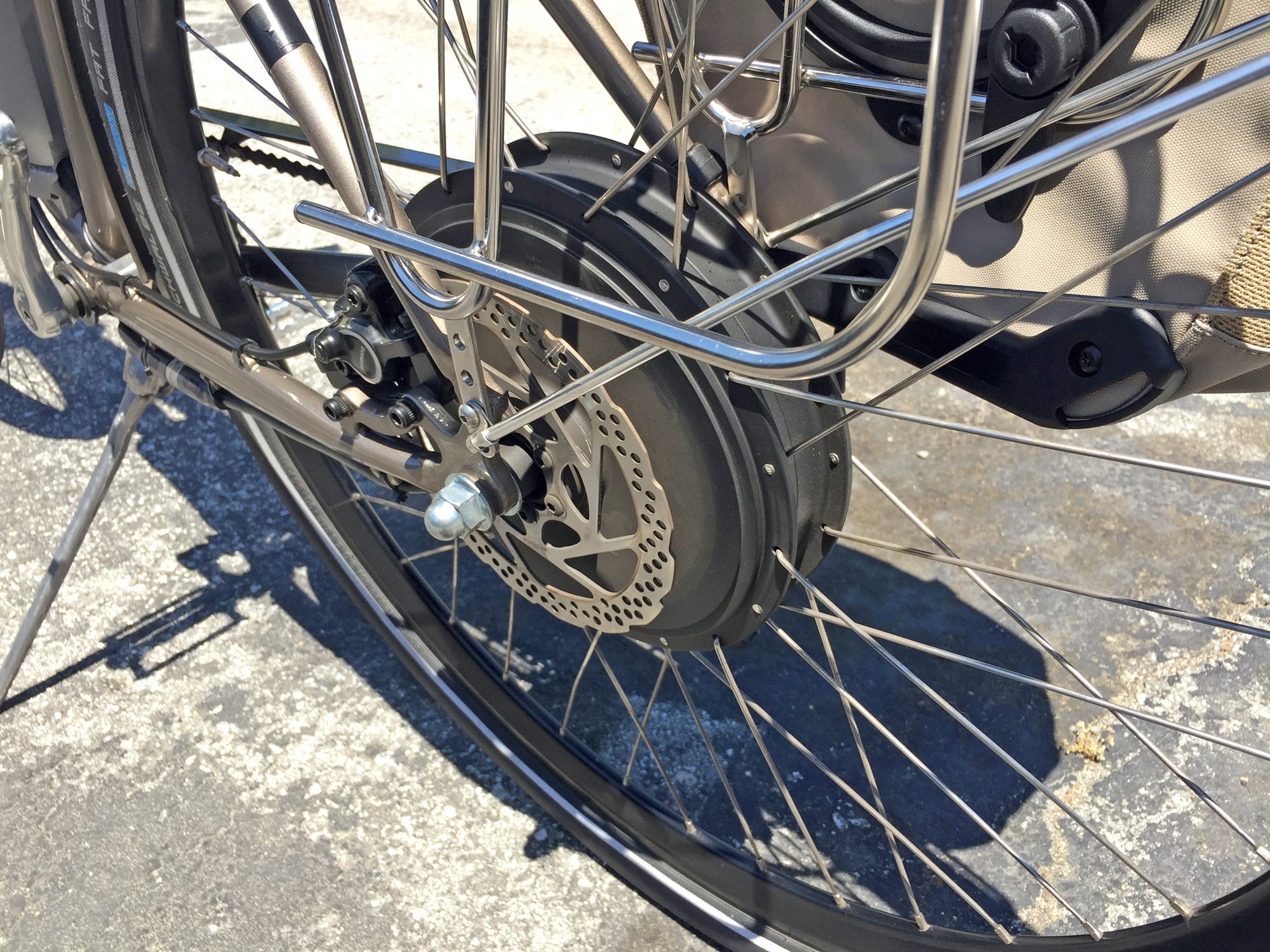
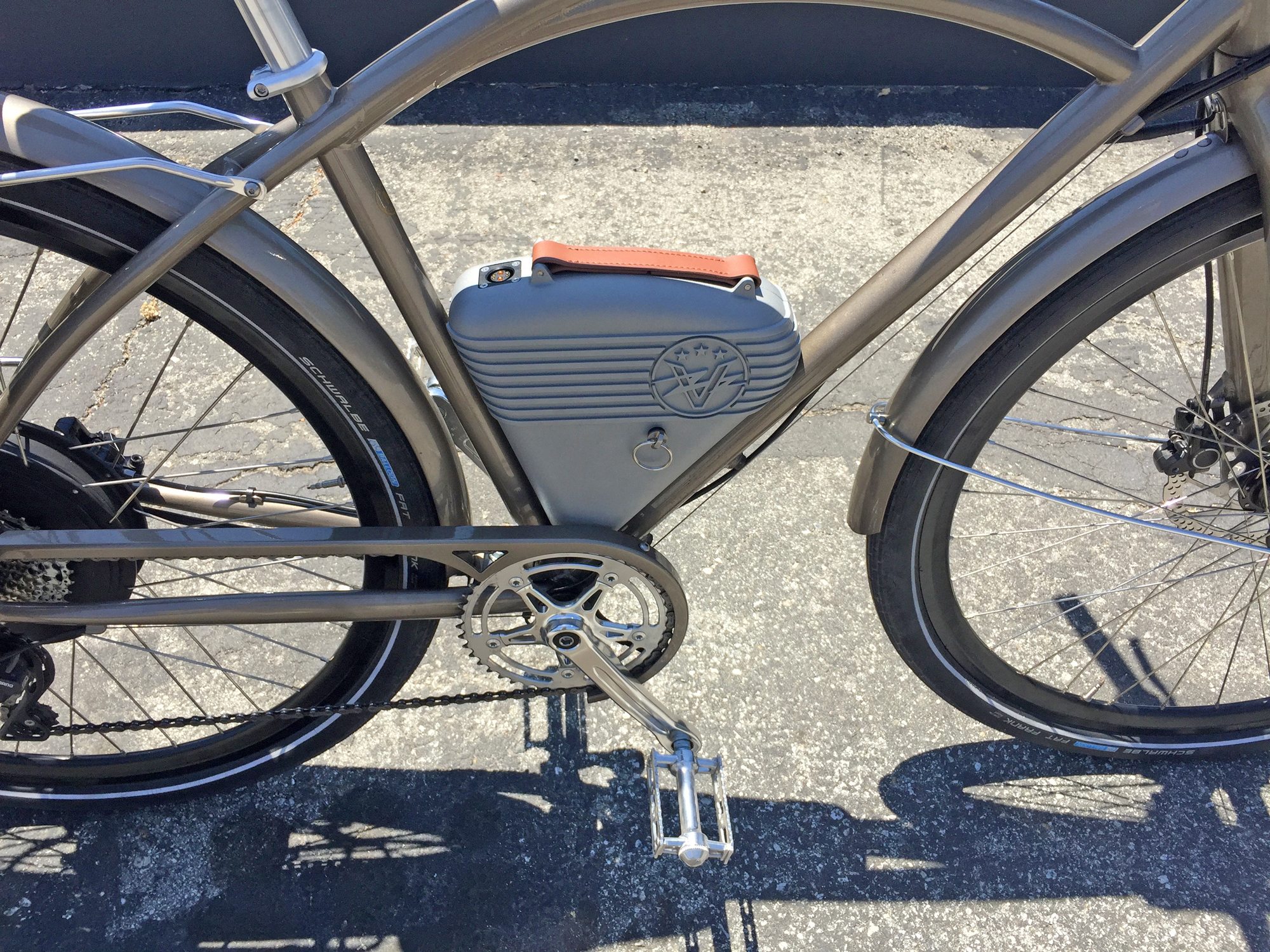
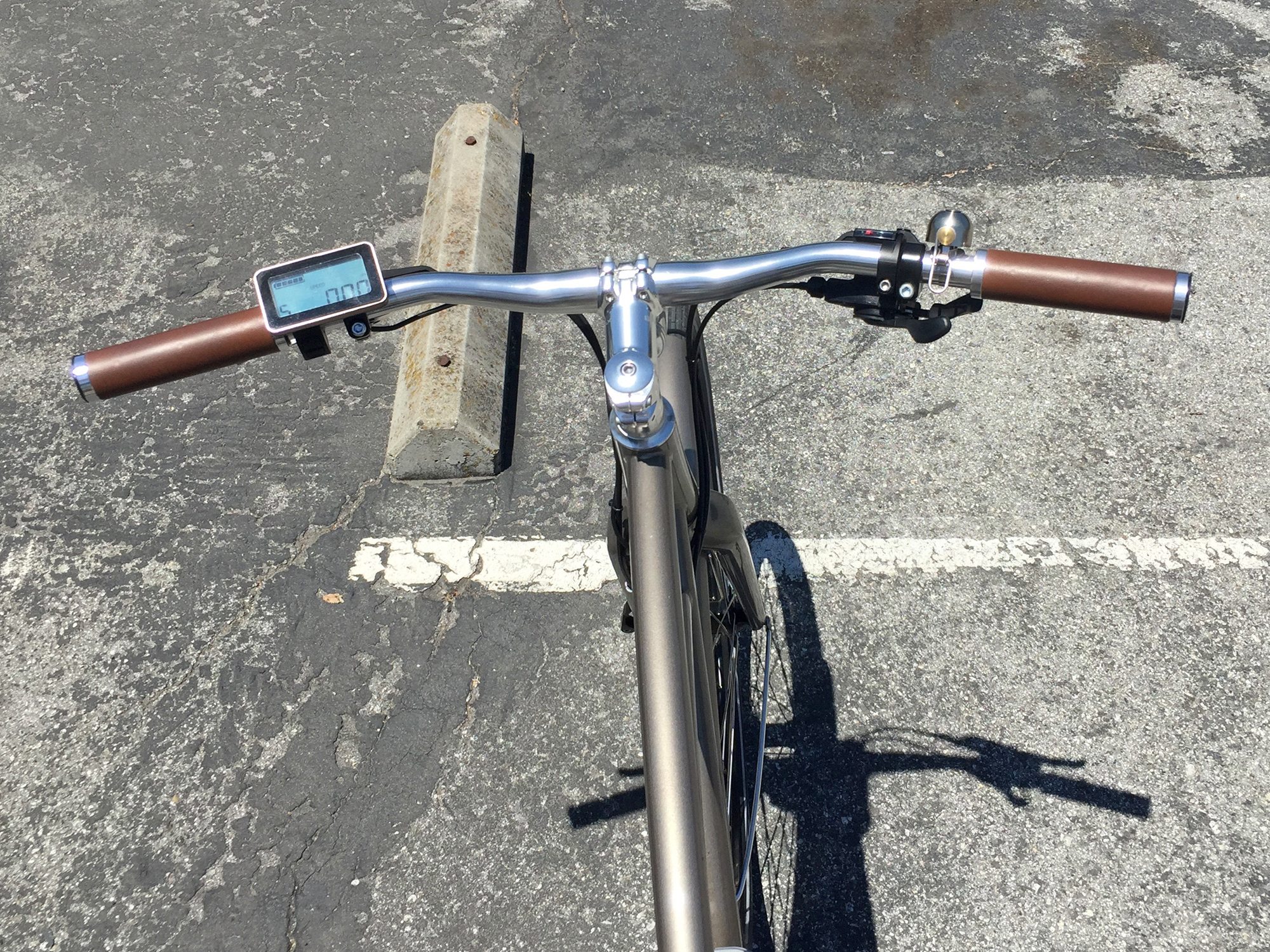
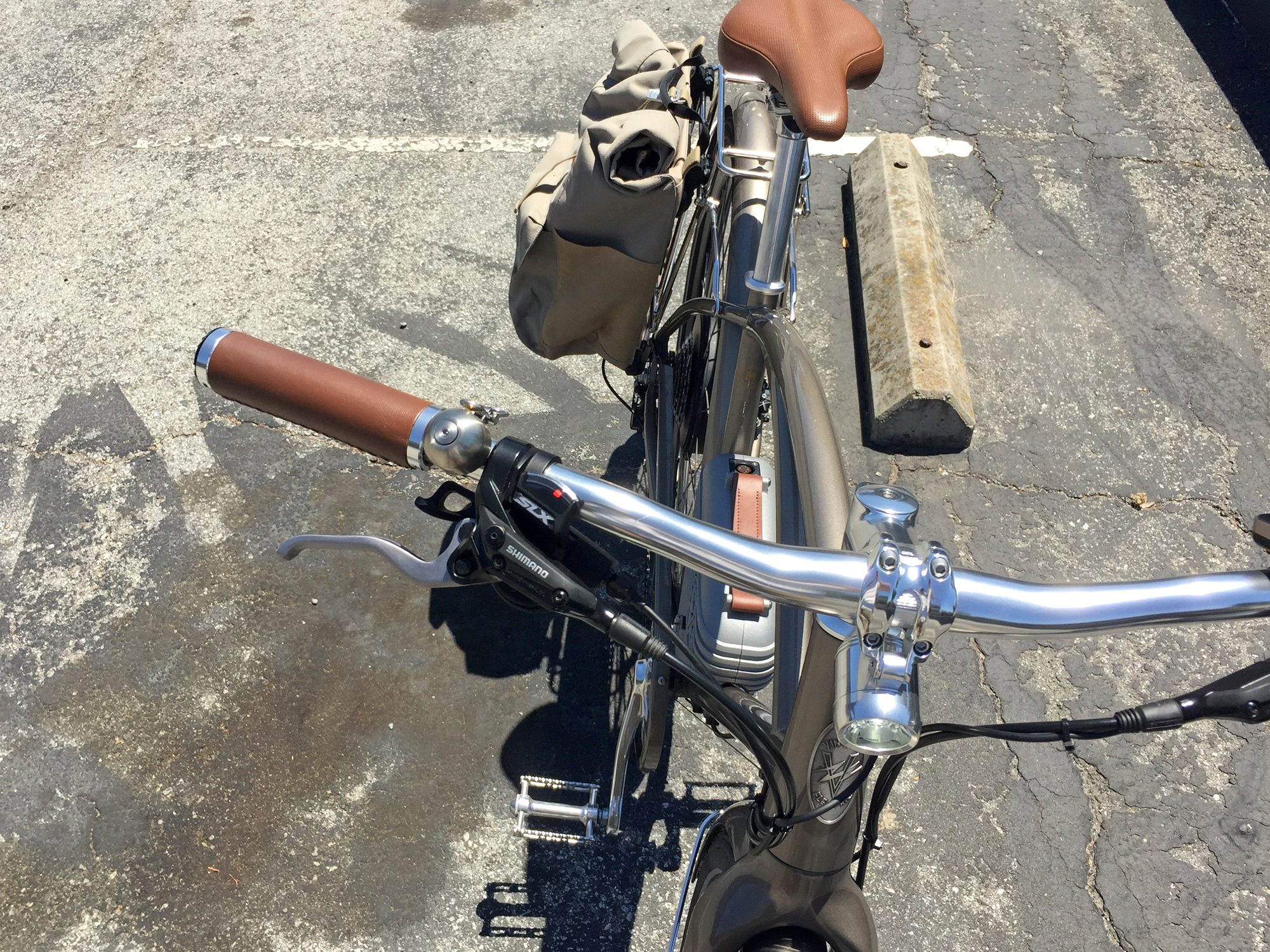

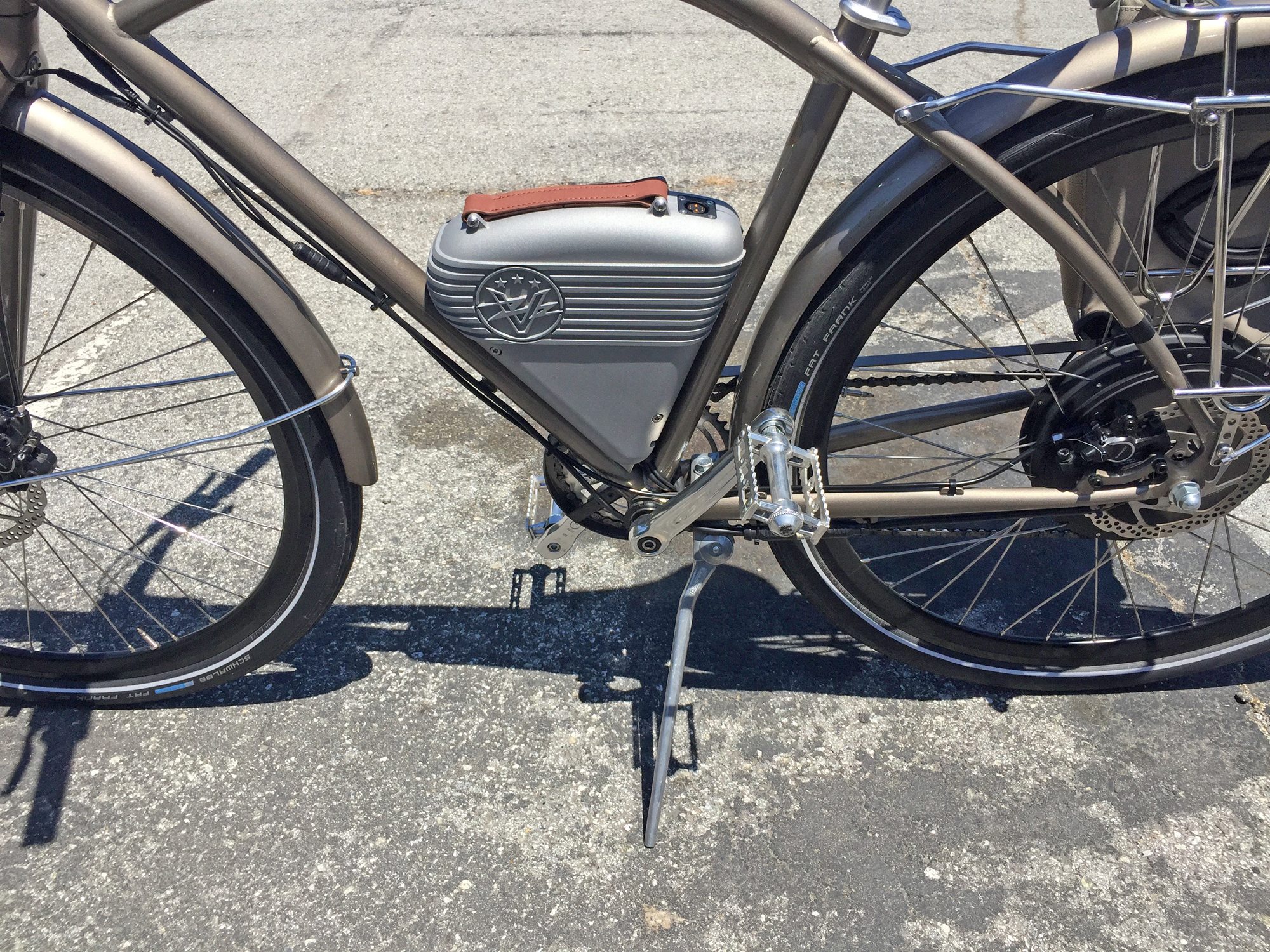
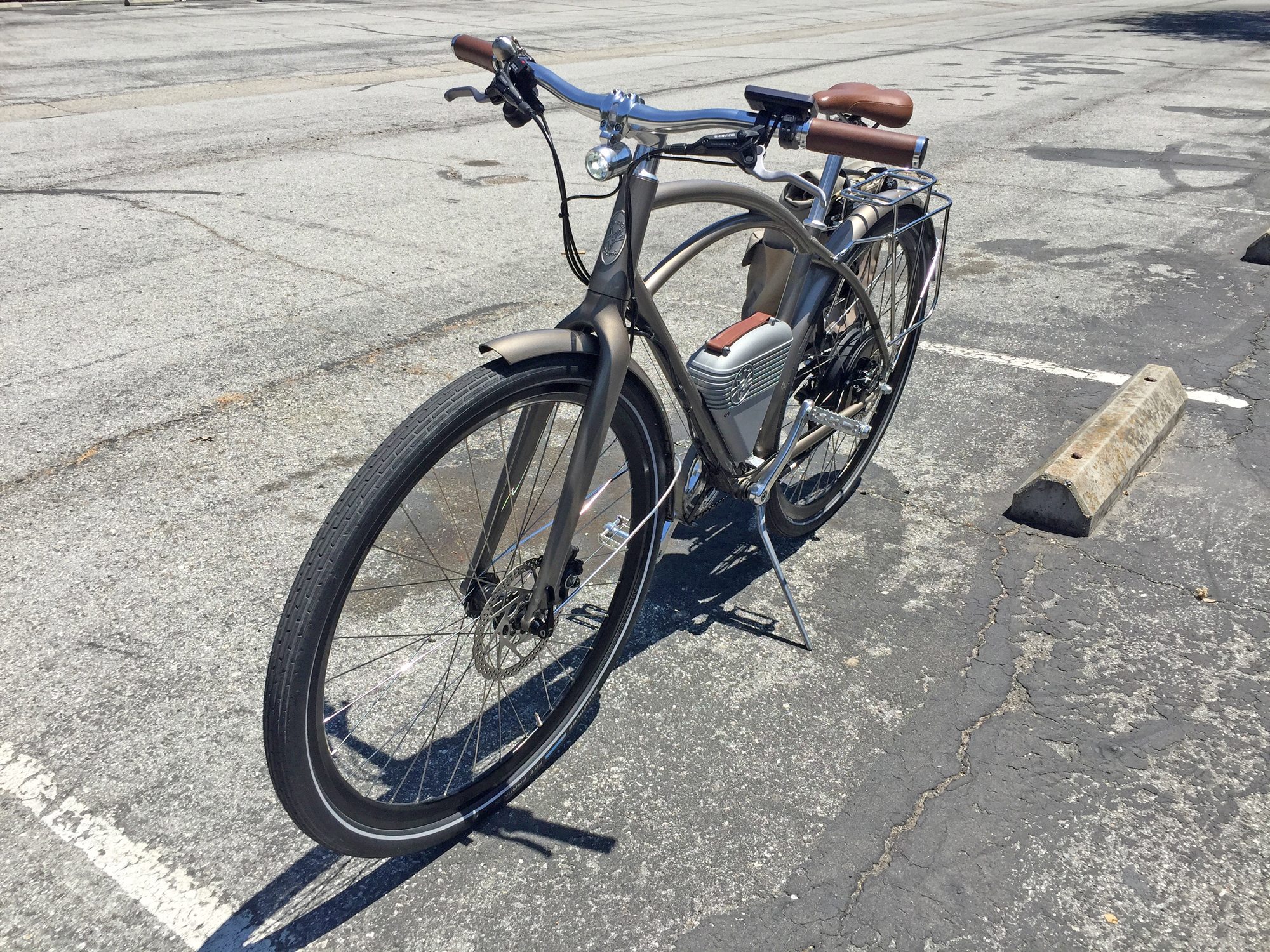
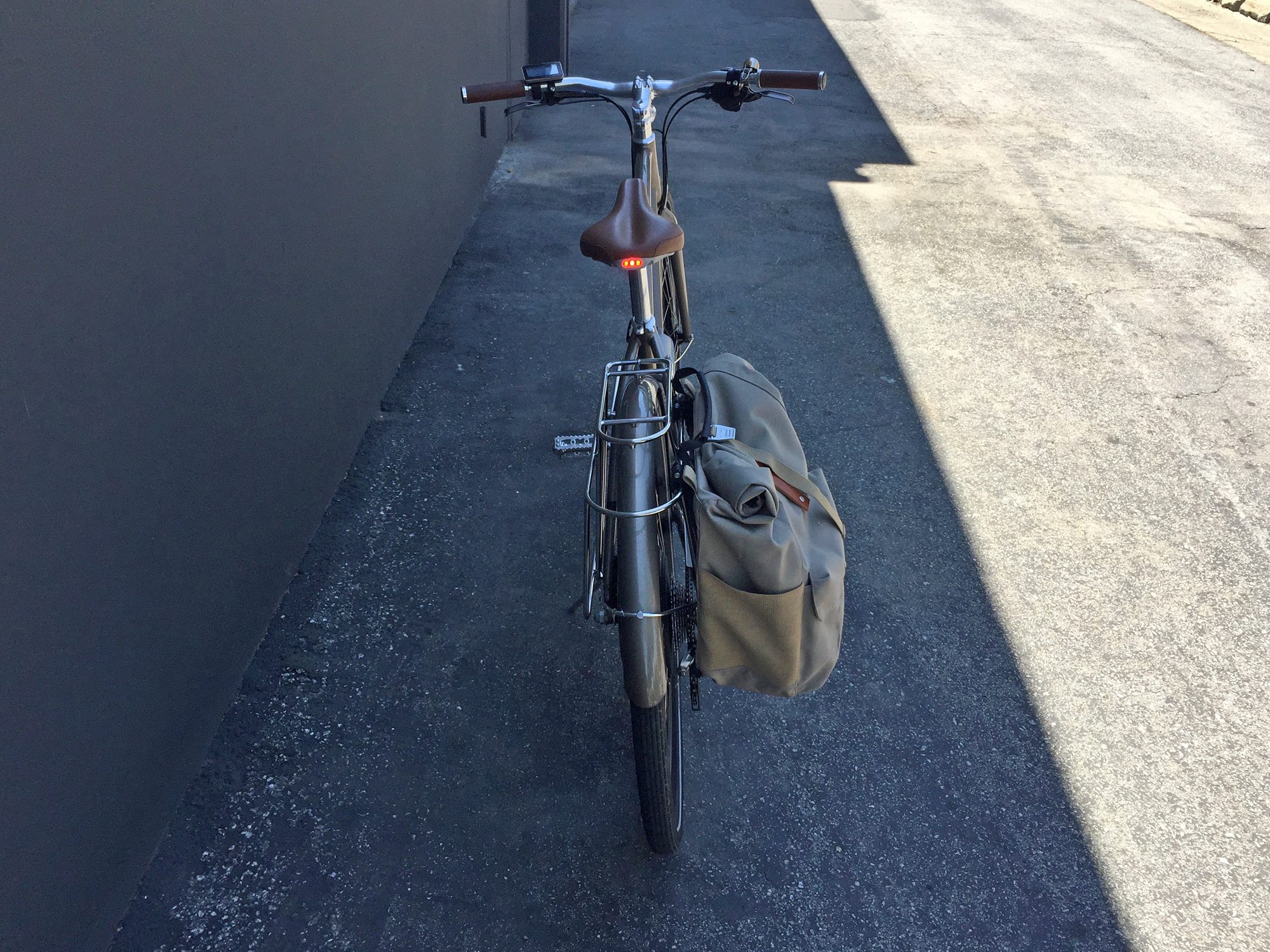
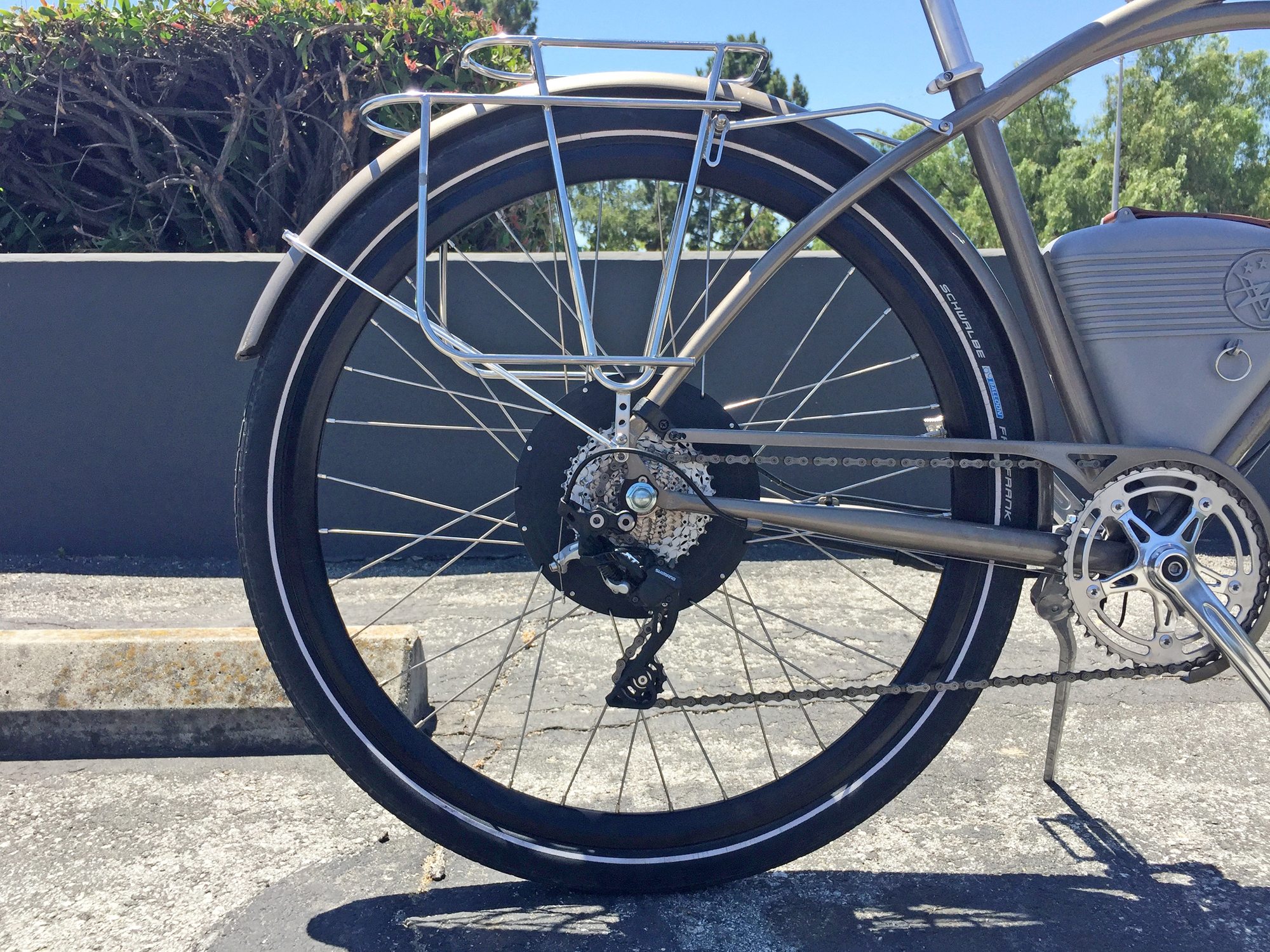
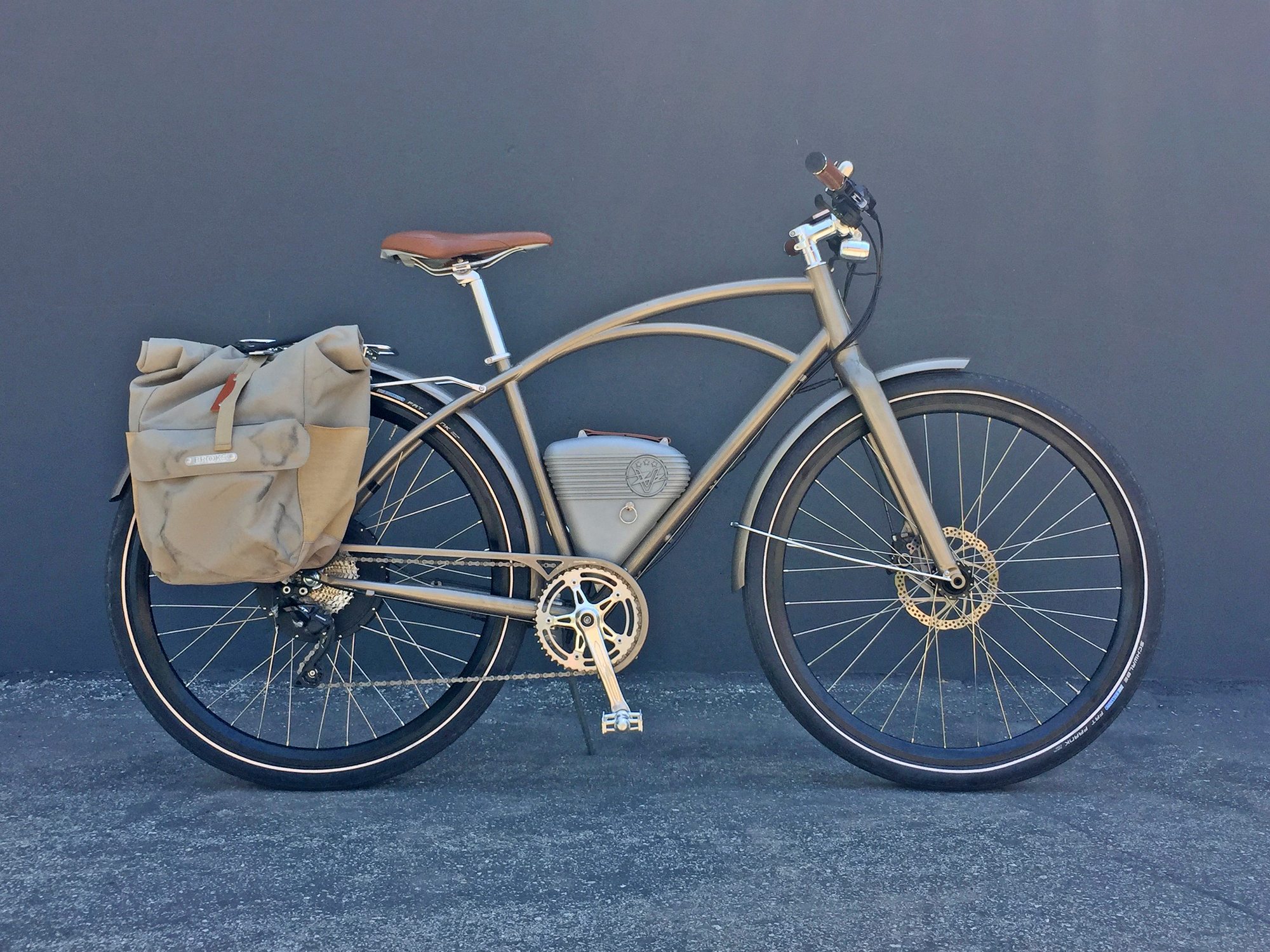
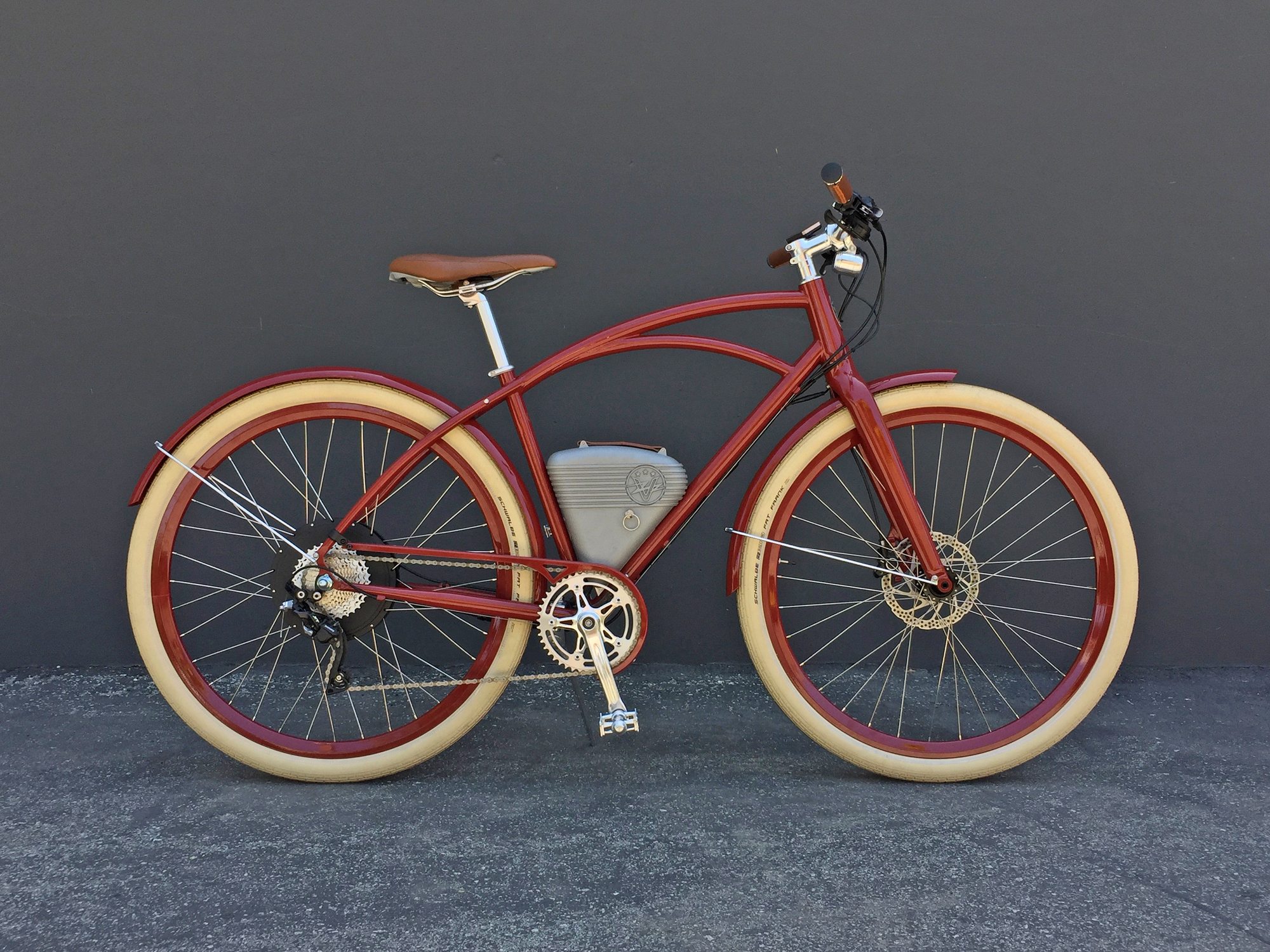

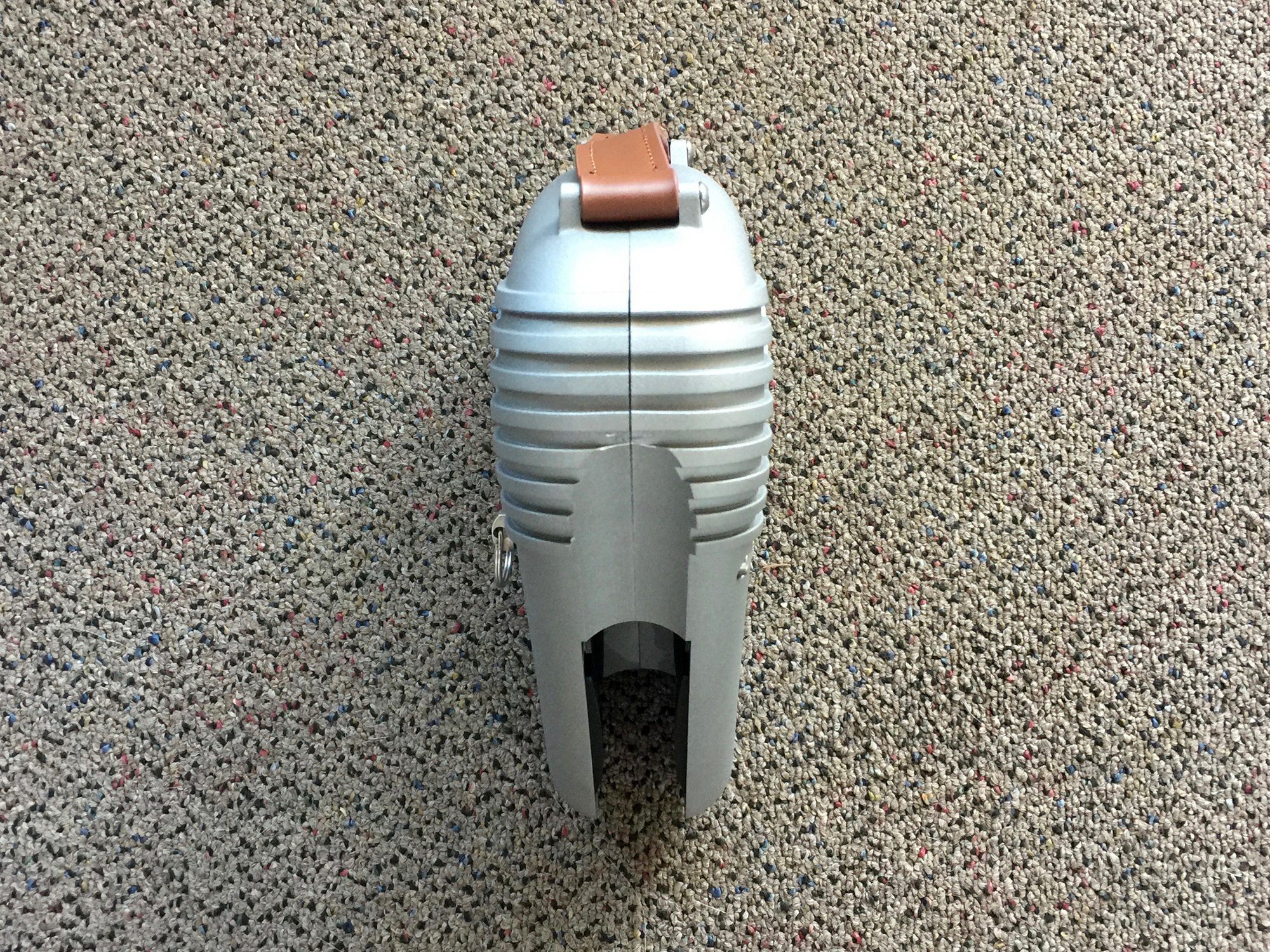
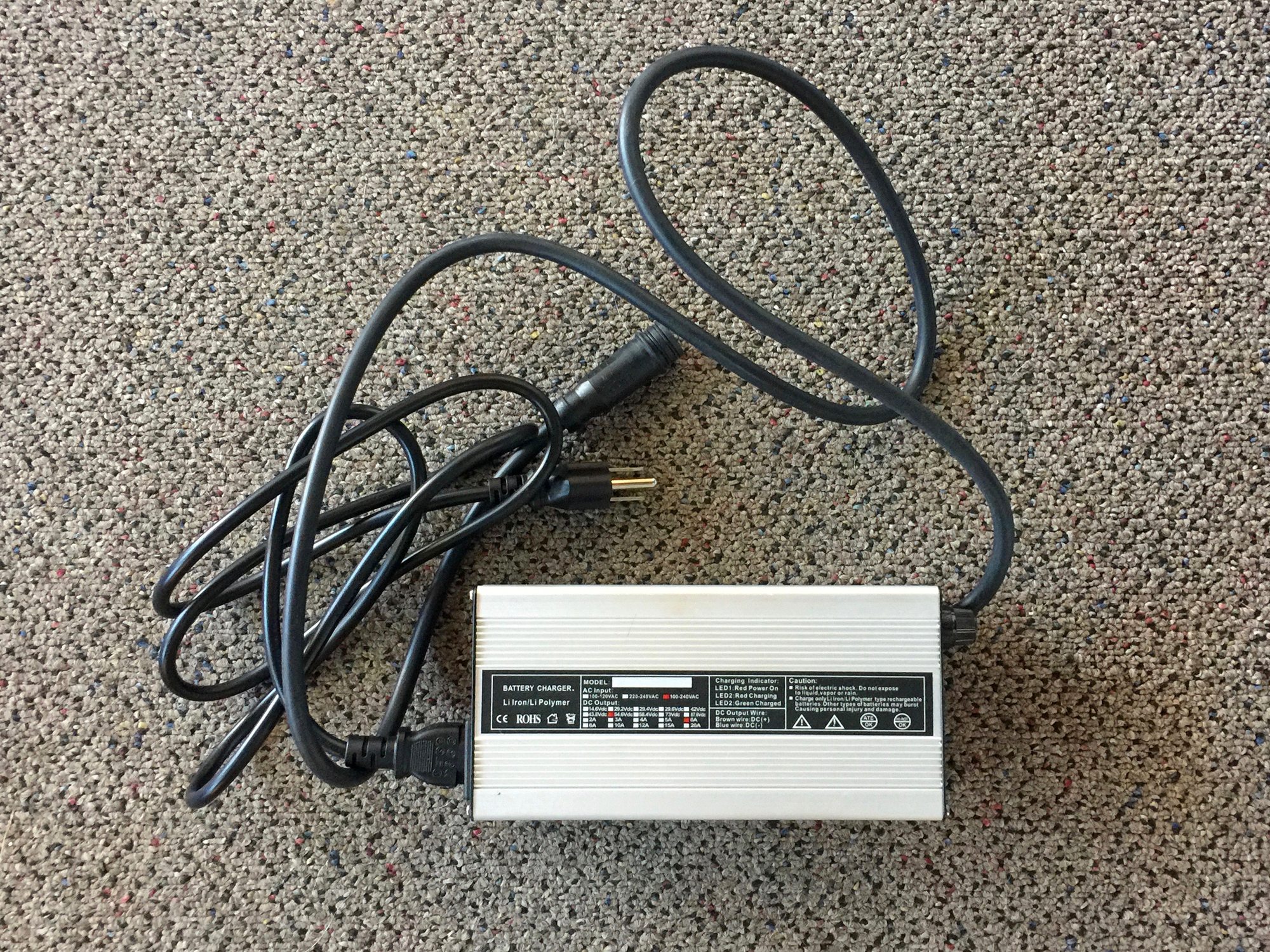
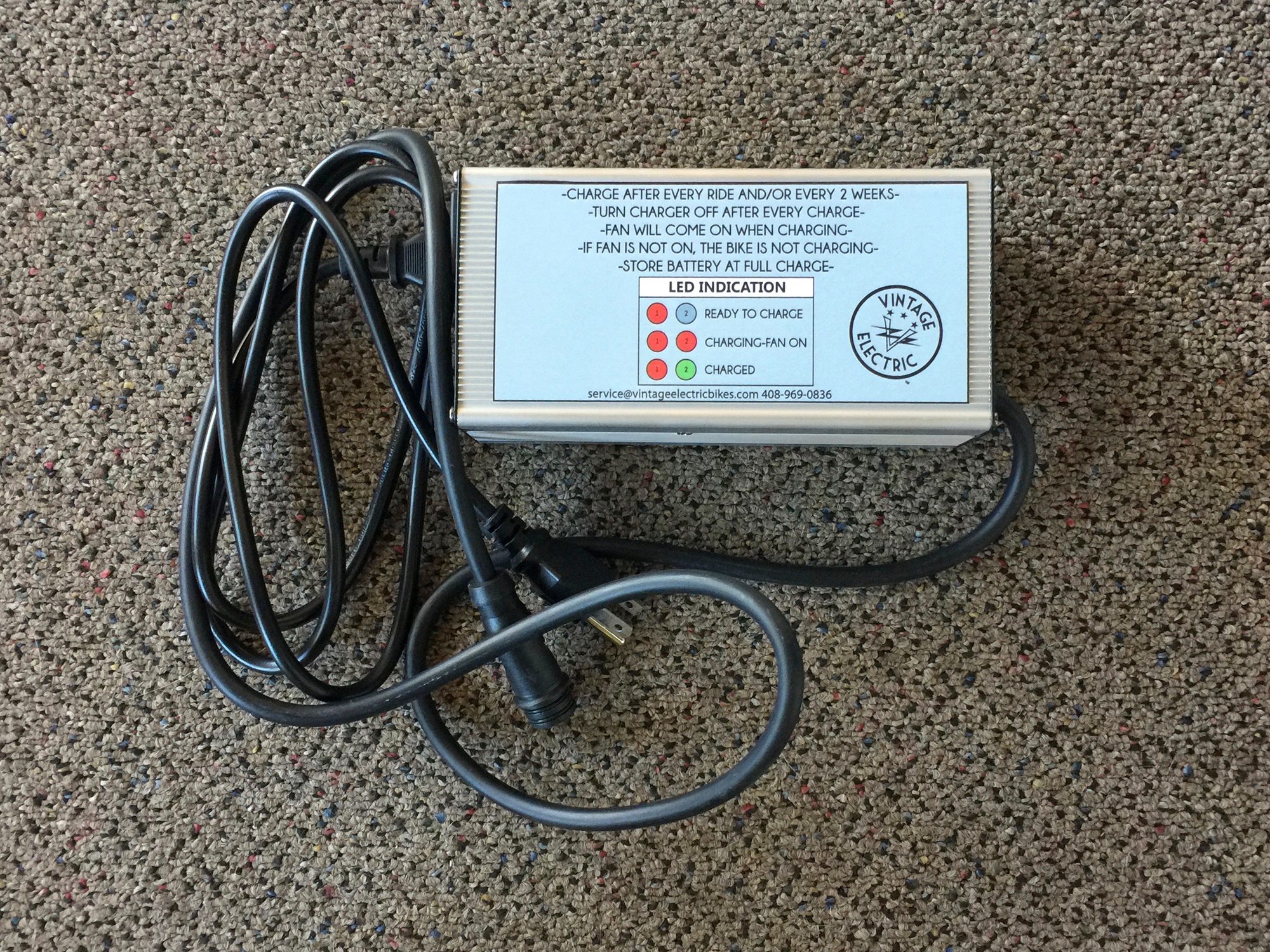


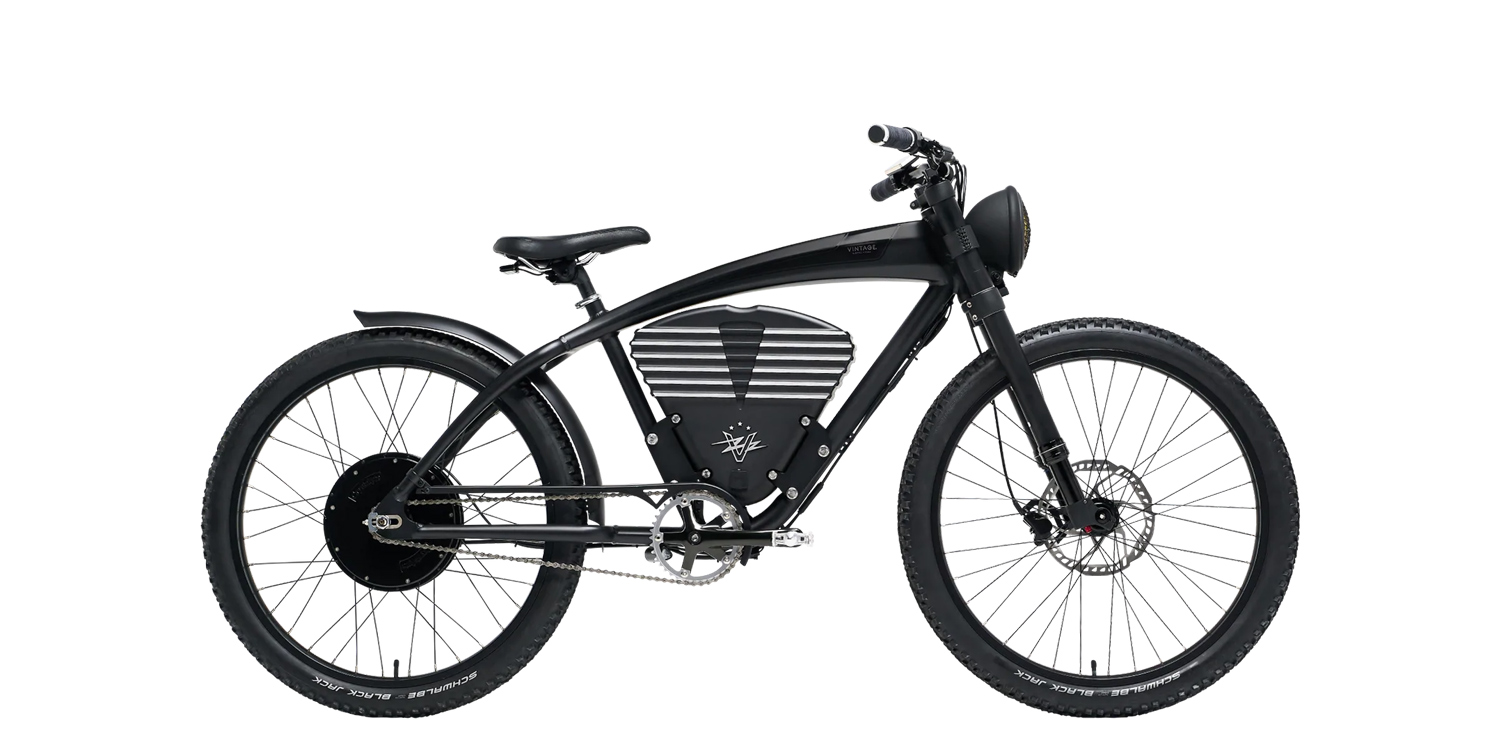

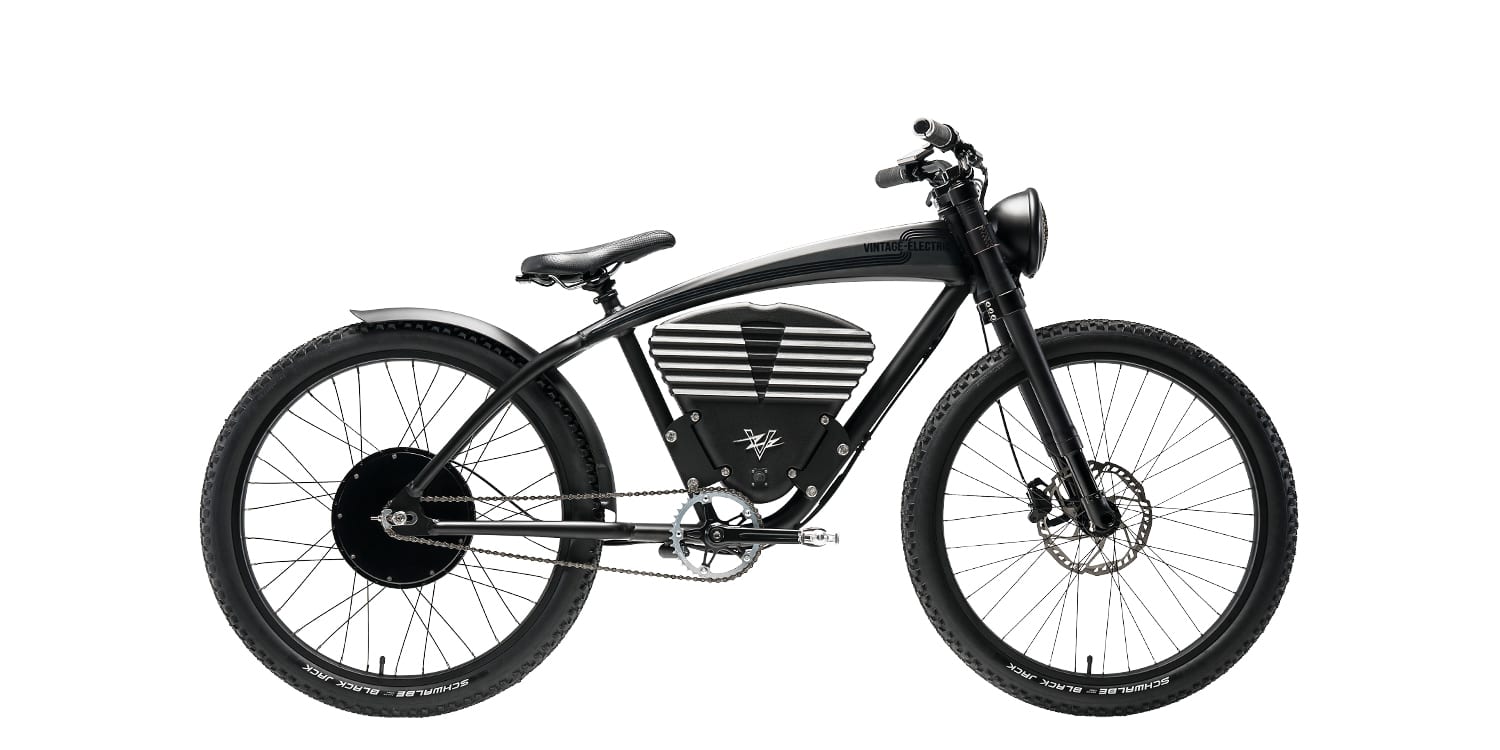
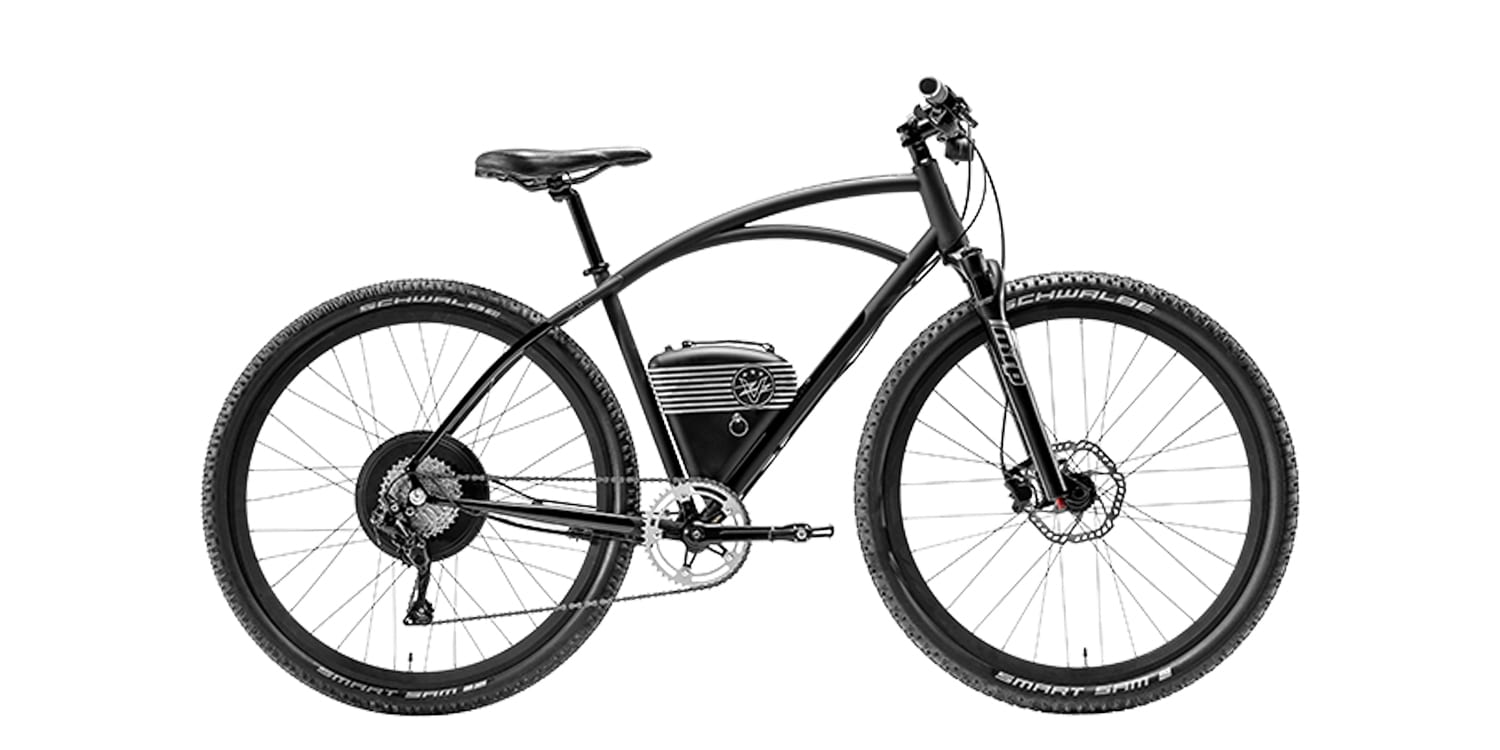
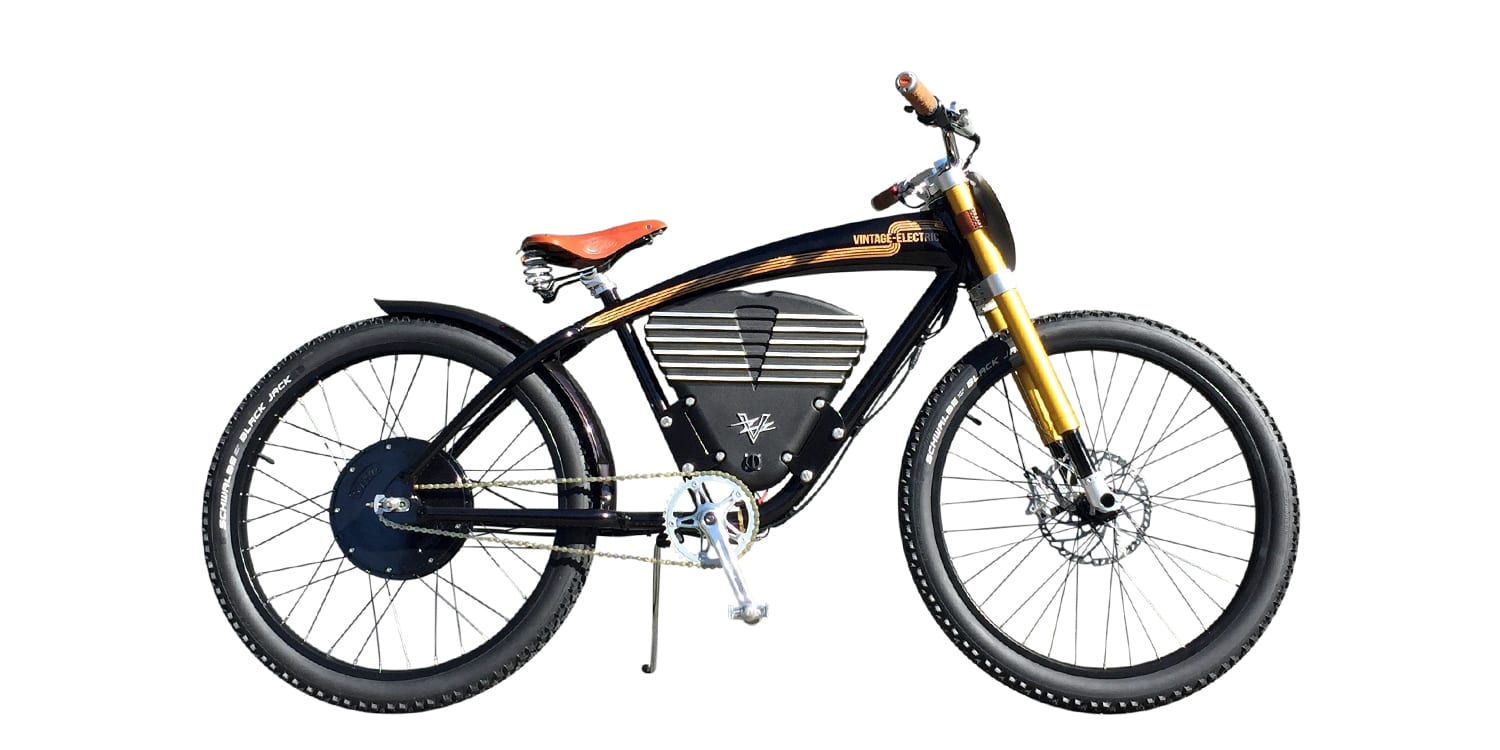
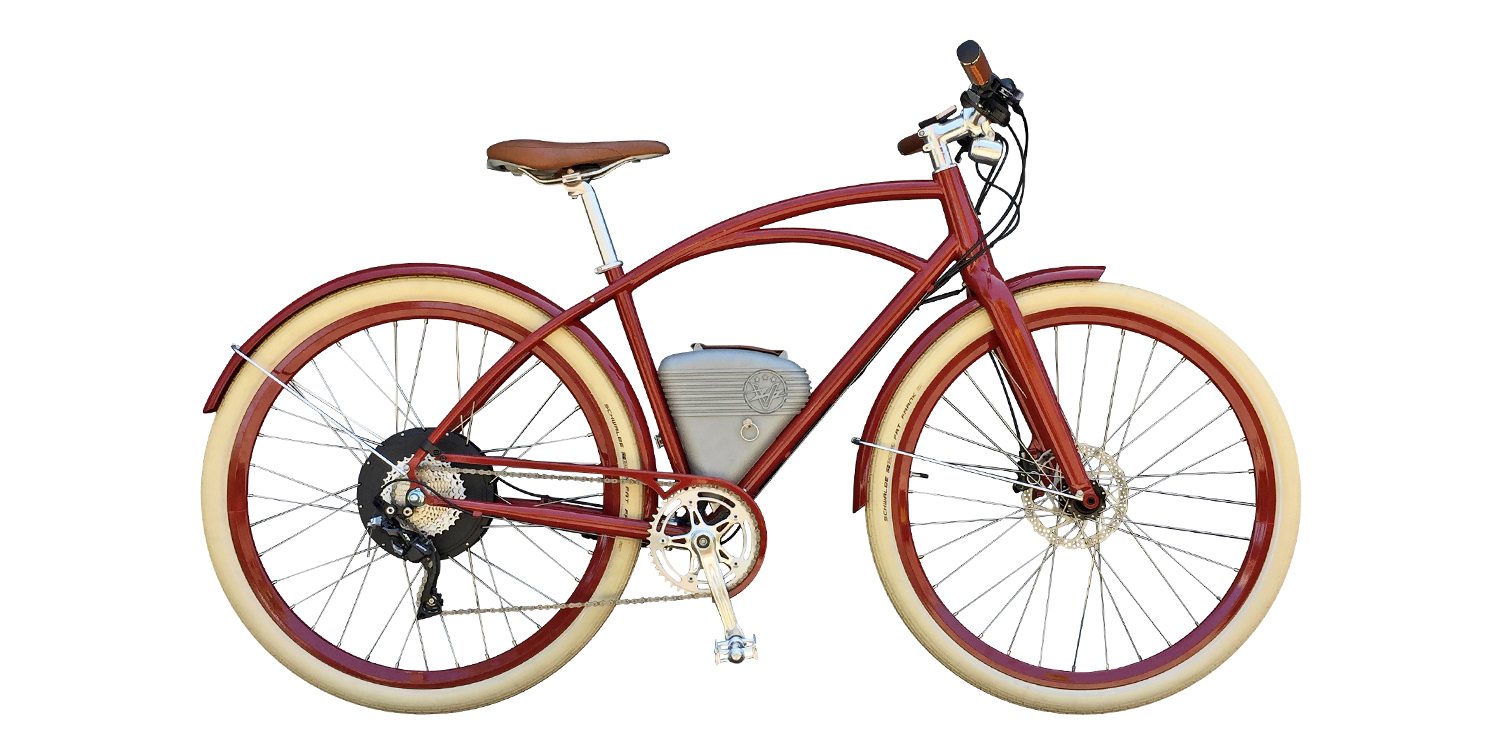
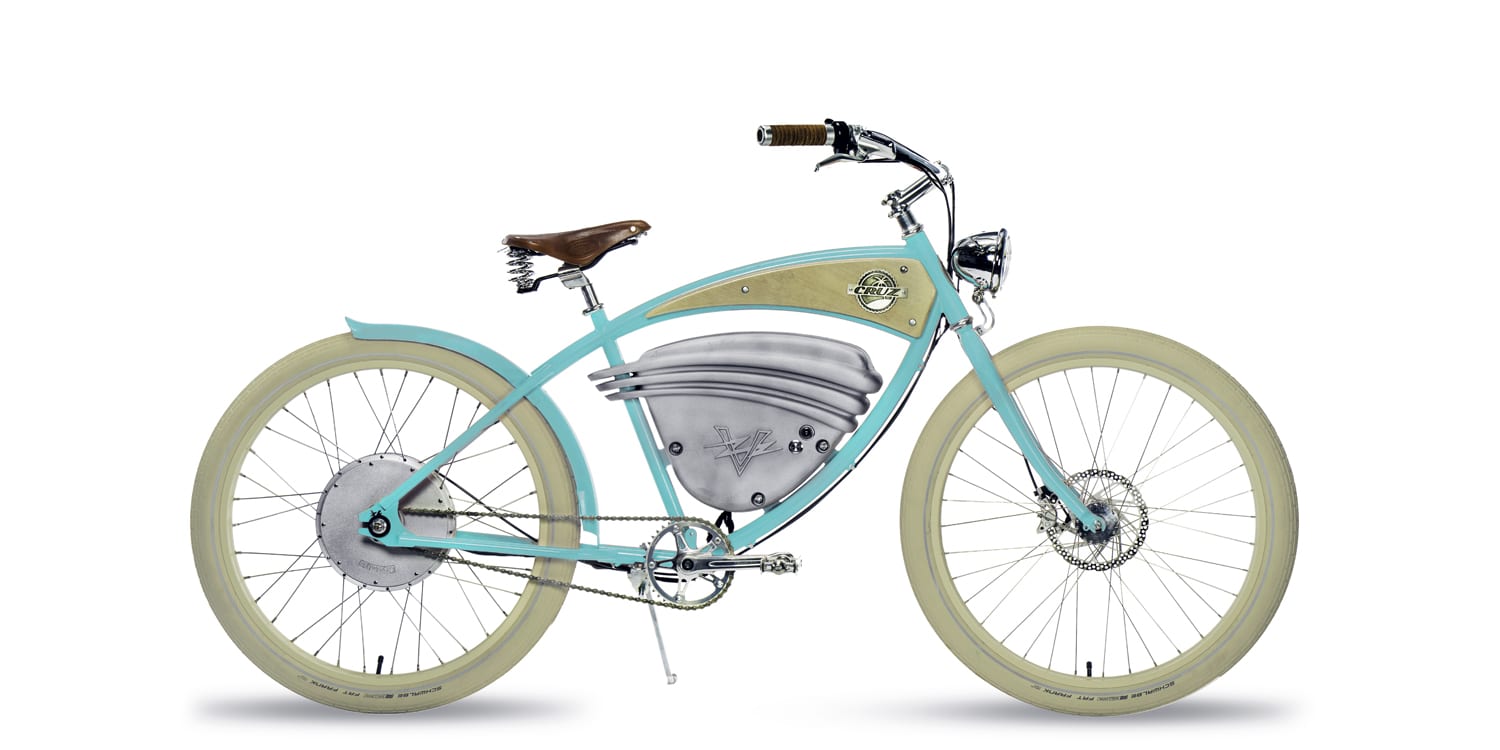
Larry says
I actually felt like the exposed wiring on this particular bike wasn’t just for convenience and cost, but was consistent with the cafe racer aesthetic. Cafe racers are classically small displacement bikes hot rodded for speed by young amateurs. While a certain amount of individual aesthetic polish is characteristic of these projects, sacrificing all other interests for speed occasionally meant leaving engine details exposed, and having random wiring all over the underside.
Court Rye says
Hi Larry, it’s interesting to learn more about the history of cafe racers, I like how you described them as “hot rodded” by young amateurs… very cool. I bet I would have loved that scene if I was a young man during the 1960’s in Britain. I have been enjoying the Wikipedia page about Café racers and appreciate your perspective on the wiring aesthetic.
JS says
Did you like this better than Bulls Lacuba E45 or Haibike Xduro Trekking (X). I know they are way different bikes. I’m interested in S Pedelec for an urban commute (30 miles RT, can charge at work…)
Court Rye says
Hmm… I was surprised by how well the Vintage Cafe performed, how quiet it was, and that it could be used for the same sort of application as the Lacuba E45 or Trekking models. I came into this review thinking of the Cafe as more of a pretty cruiser than a viable commuting option… but I really think it is, the feel is a bit different and there is no suspension fork but the feel is good.
weazal says
I stalled out purchasing my 1st eBike due to my 6’4″ height restricting bike choices to expensive brands that have different sized frames (e.g. Kalkhoff/Focus). It was hard justifying $4k for a bike when I could get a car for the same price. It wasn’t until I discovered Vintage’s eBikes that their style was enough to finally justify the cost.
After your first hand experience with the bike, would you mind relaying how it might impact my unique needs? My greatest priority is a comfortable commute on flat L.A. streets for 3 miles and casually/comfortably exploring the steep Hollywood hills nearby. What’s your opinion on how comfortably the Cafe could handle frequent/long hill climbs?
Curious what bikes you might recommend instead – if the Cafe’s not ideal? I’m MOST interested in ones that share the Cafe’s style, but also curious what the absolute best bike would be regardless of style/cost. To be clear, my needs are: comfort, hill climbing, and my 6’4″ height.
Hope you don’t mind… you’re such a valuable resource I would really treasure any insight!
Court Rye says
Hey weazal! Glad you were able to find something that finally struck a chord. There’s nothing quite like the Vintage ebikes in my opinion, and the Cafe model really impressed me with its smooth, quiet power delivery. It feels solid and fluid. It’s not going to be as efficient as a mid-drive, but it’s definitely fun and faster to accelerate. You’ll have to shift gears in order to climb (as with most electric bicycles) and pedal along smoothly, but it should be capable. The fatter tires offer good comfort and I really appreciate the lights (especially for big cities). An alternative would be something like the Haibike Trekking 4.0 which costs $2,500 and uses a Yamaha mid-motor. It will be slightly louder, harder on the drivetrain if you don’t shift carefully (no shift detection) and won’t support faster pedal cadence to hit higher speeds (you really have to shift gears to get the power and speed because the motor has a 100 RPM support limit). By comparison, the Vintage motor is completely separate from the drivetrain, so you can pedal however you want and the motor always feels the same… That’s the benefit, but also why it’s not as efficient. If you shift gears on the mid-motor ebikes, they will climb more easily and use less power. I hope this makes sense. I filmed some Haibikes today and saw the 4.0 as a great deal since it’s the entry point in the Trekking line. It has a suspension fork, fenders, rack, lights, and I reviewed something similar in 2016 that you can check out here. Again, just tossing this out because it’s top of mind and a bit less expensive.
Carlos says
Hi Court,
Wondering how you would compare the Cafe to the Stromer ST1. ATM i can get an ST1 with front suspension, rack, and bell for $1000 less than a Cafe that does not offer those accessories included. But the Cafe offers 700 watts vs 500 watts and 70 Nm vs 35 Nm. The Cafe is aesthestically appealing in a retro sense, while the St1 is appealing in a modern sense. Stromer has been around longer and there is a shop near me, while the Cafe is a slightly younger company. And although what initially attracked me about the Cafe was aesthestics, after much research and comparison, it seems pretty comparable to a top line urban commuter bike like a Stromer ST1 or a Trek Super Commuter 8s.
court says
Hi Carlos! Excellent question… I do prefer the performance of the Vintage Cafe. It’s super powerful and fast! However, I usually opt for a dealer supported local bike when possible, because that brings fitting, tuneups, support etc. and I have had great luck with the quality of the ST1. I think you’ll probably be happy eithe rway, but the addition of the suspension fork and rack could be very useful for commuting, or if you have a sensitive back and neck like me. I always love suspension and usually opt for suspension seat post and even different swept-back bars. I hope this helps, I’d love to hear what you go for and how you like it :D
Ida says
I test road both the Stromer and Cafe and totally agree with Court. I should have liked the Stromer but the Cafe felt better. I bought the Cafe and am deciding now whether I am going to keep it. My only issue is battery removal (which seems impossible), charging isn’t working but could be user error, and the only deal breaker is the vibration. I’ve always hated suspension bikes but being a lady of a certain age now… it was a painful ride by the end. It’s been a long time since I’ve been on a bike so the fact that it’s got me out there riding is a big deal. Thanks Court, for the service you provide, quite a niche you’ve developed for yourself. Many of us are grateful. I’ve been following for years and am excited to finally pull the trigger. We’ll see what I end up with.
Court says
Congrats on the purchase, Ida! I enjoyed reading your comment and can totally relate to the vibration challenges, especially at higher speeds. Have you considered a suspension seat post? Also, check the air tire PSI rating (which I try to list here) and consider going lower to reduce some of the jar on rough terrain :)
Carlos says
I ended up with neither a Stromer or a Cafe. Did more research and found a less expensive bike in the Juiced RCS. Got it in January this year and have put over 700 miles so far. Absolutely love it. The fat tires provide comfort, stability and versatility. Only modifications made was purchasing a swept back and slightly raised handlebar, the Jones h-bar and a sprung saddle, Brooks Imperial, rather than a suspension seat post to save money since I figured the fat tires would help with comfort anyhow. I am so happy with this purchase, this site and your assistance and guidance have been tremendous.
Gary says
Hi Court, this thread is a big help. The Cafe design, technology, performance, and simplicity combination works well. Speed Pedelec Class 3 with a smooth, rider friendly PAS (throttle not required), and a $2.5k – $4k+ price range is growing category. Juiced is getting on board and I am hoping FLX jumps into this mix (they could really shake things up). Does a Class 3 speed pedelec capability translate to overall high performance including hills and range? Which of the three Cafe, ST1, or Haibike Bosch 350w,would ride the best in the hills of San Francisco, Seattle, or Palos Verdes?
court says
Hi Gary! My experience with speed pedelecs is that they usually compromise torque and low-speed power for performance at the high end. You can see this with the Bosch Performance Speed motor, which doesn’t quite get to 28 mph unless you really help, and doesn’t offer as many newton meters of torque when starting as their CX motor. As for SF, I’d probably lean towards the Vintage Cafe or Stromer ST1 model for steeper hills in SF. Both use gearless hub motors that are heavy but powerful from start and very capable of hitting an actual 28 mph top speed. I’d put Vintage in the lead, but Stromer does a great job and the ST1 was pretty reliable for me and my family. The Haibike will get the best range and empower you well at low speed if you’re in the right gears, but it will require more frequent shifting and fade out as you rise above ~25 mph.
Gary says
Court, thank you for the reply and thanks to everyone on this thread. EBR reviews are the definitive independent ebike knowledge resource on the web. I would still like to see specific analysis and pros and cons of a bike’s PAS in future reviews.
My take away: PAS matters (throttle mashing is not enough). TDCM Hub Motors Rock! Bosch CX and the equivalent Brose are a better overall mid-drive option than their speed drives even though Class 3 performance may not hit 28 mph. Bafang, especially their Ultra mid-drives and worthy TDCM hub challengers, need to make a strong showing with Versatile California Class 3’s. I am 5’7” and 30” inseam (measured for bike riding) and the Cafe cruiser frame may be a hassle. But the pros may override that con. I prefer purchasing and support via a shop, which Stromer and Haibike provide. But, Vintage has said if I can find a local bike shop who is willing to assemble and set-up the Café, they will reach out to the shop and offer support and liaison during the process (I could even ship directly to the shop). I think their bike is easy to assemble by the owner, but that is awesome online customer service. Finally, pros, cons, and trade-offs will never go away. Thanks, again.
Carlos Bido says
Hi Court and Gary, I keep going back and forth between the Cafe and a Stromer ST1. I’ve got a lot of time as I don’t intend to get one until the end of the year. I agree that a local retailer is important. I actually emailed VEB about this, and their response was as follows:
“Any reputable local bike shop will be able to service and tune up ours bikes. The beauty of our Cafe is that there are no more moving parts than on a traditional bicycle. For the bicycle components, any bike shop can service. For the e-drivetrain we designed it to be modular such that if there ever was an issue it can pretty much be diagnosed via phone with our service techs, and then through the local bike shop we can advise on how to do part swaps. This has worked very well for us our customers in areas where there is no local VEB dealer.”
That was reassuring. In fact, I will contact the local retailer where I tried the Stromer to determine if they have worked or are willing to work on servicing and tuning up a Cafe (they have other ebikes there too). If not, I suppose I’ll have to take the horrible drive to Santa Monica from South Pasadena (little sarcasm there, LA is beautiful from the east side to the west side) for tune ups and service if I go with the Cafe.
I’ve been reading that the ST1 may be discontinued, therefore taking me out of the price range which means moving up to an ST1X or ST2. On the other hand, I like that the VEB is American made and in fact from California as I am a Los Angeles resident. If Stromer is the Tesla of ebikes, I suppose that the VEB is an All-American muscle car, because the battery and motor on their low end ebike can compete with some of Stromer’s top of the line bikes.
I really think Davidge did a disservice to himself and his great creation of an urban commuter when he was quoted saying they were not trying to compete with someone like Trek Supercommuter when in my opinion, it blows the Trek away. Nonethless, the Cafe needs to come standard with the rack and bell though as it is unique to that class of ebikes, urban commuter.
court says
Hi, Carlos! Great summary there… You might be able to get a discounted ST1 if they are indeed phasing them out (I haven’t been told anything about that). Andrew Davidge started Vintage from scratch and has had some amazing success, including that interview with Jay Lenno. His products are beautiful, powerful, and they put a lot into legacy support. I really like the Cafe model, it peforms well and looks so beautiful! Perhaps it could be a fun adventure visiting them on occasion, even if there were issues, but my feeling is that the bike would hold up very well over the long term. It just feels super solid and uses parts that don’t seem as delicate as a few of the Stromer items (like the plastic display on the ST1). I’d love to hear back about what you go with and how it performs eventually :)
Gary says
I put together a bucket list. Performance + Versatility + Fun + California legal + Value Pricing = 2018 DODGE CHARGER SRT 392. Or an awesome electric bike for a lot less.
The bike equation: High quality PAS and sustained (by rider and bike) 20-28 mph on flat roads + Versatility (hills, range, speed, handling, comfort, durability, and reliability) + desire to ride everyday + A 750w nominal motor or less (no jail breaks) and Class 3 compliant + doable at less than $4k(ish) = ?
The VEB Cafe packages performance, versatility, style, and *Simplicity* better than anyone. VEB customer service seems to be first rate. Can Stromer, FLX, and others answer the call?.
Note: No commuter should be worn out on a daily class 3 commute including commutes in SFO and SEA, and this category has potential economies of scale.
Thank you Court and every contributor on this thread, it helps.
Eddie Johnson says
Hello all! This is Eddie from Vintage Electric, and I love to read through these comments from time to time. Court, you are an absolute gem for all of us in the industry, and full of great un-biased knowledge for our owners!
I am posting for all those who read, to let you know that we do have a front suspension solution for the Cafe. Please contact us directly for pricing and details on the suspension fork (same fork maufacturer that builds our inverted fork for the Tracker and Scrambler models, MRP out of Colorado) as we currently do not advertise it anywhere.
On my personal Cafe, I have removed the fenders, added an MRP front suspension fork, installed WTB Riddler 45c micro-knobby Skin Wall tires, and a Brooks B67 saddle with our integrated Supernova Rear LED… the bike is an absolute dream to ride 20 miles each way on my commute at 28+mph. The addition of the front fork and springs in the Brooks B67 saddle, compliment the comfort of the Cafe Chromoly Steel frame very nicely!
Hope this helps spark some enthusiasm and inspiration on customizing the Cafe.
Regarding the comment about local retailer support – we partner with only the best shops who can provide support and enthusiasm for Vintage Electric, equal to our own. If you are in an area where we do not have a retailer, we (I) will provide the 5 star concierge service via phone and email after placing an order directly with us through our website http://www.vintageelectricbikes.com or via phone (408)-969-0836. We will work with a mobile bike shop like VeloFix, or a reputable local bike shop for assembly and delivery. We ship directly to said shop for assembly so that you don’t need to worry about transporting the large shipping box, and then can continue to work with them as needed to support your ride. We have operated this way since our inception, and it proves to be a very nice way to bridge the gap of not having a local retail/service partner. We design our bikes to require minimal service, but if needed, we try to go above and beyond to make sure you and your bike are back on the road swiftly! Vintage Electric is a family of enthusiasts, and we aim to treat you that way.
Heres to more pedaling, and less time cursing traffic ;) We hope to hear from you with your questions and are always happy to chat!
Cheers,
Eddie
court says
Great comment Eddie! Thanks for sharing the updates about your suspension fork update and clarifying how the shipping/assembly process works. You guys have always done a good job with customer service and I’ve had a blast riding your bikes for the reviews here. Hope the year is going great for you!
Jimmy J says
Purchased one Cafe from Eddie. Getting it next week (8/23/18). Tested several bikes (R&M, Stromer, Trek, Specialized) and decided on VEB. Thanks for the review.
Court says
Awesome! Glad you found an ebike that really fits. Hope it works great for you and feel free to chime in as you get some time in the saddle, thanks for the compliments about the review ;)
H.B. says
I’ve been struggling to decide on which ebike to buy. I can’t try the Cafe in person. I have tried a Stromer ST1X to get a feeling of a powerfull hub motor bike. Can anyone tell me how the Cafe speed and power compares the the ST1X? The ST1X seems to have a lot of extra technology, which I’m not really interested in.
Also, I am trying to decide between a Cafe, a 2018 Turbo Vado 6 that is on sale for about the same price as the Cafe, and a Raleigh Tamland, which is also about the same price. I want an ebike that is fast and helps me climb hills. Does anyone have an opinion which of these bikes is best in terms of ride and power?
Court says
Hi H.B., I think that the Cafe is the best in terms of power, smoothness, and ride quality… but it’s also heavy. The Tamland is very fun and aerodynamic, but more sporty in terms of body position. I like the Brose motor and fenders on the Turbo Vado ebikes, so maybe it sits between the Cave and Tamland. Maybe it comes down to ride style? I prefer the Cafe to the ST1X, it just felt more comfortable somehow.
H.B. says
Thanks so much for the speedy reply Court! I have one very last bike to ask about. The Reise and Muller Roadster. It seems comparable to the other bikes I’m looking at, and I can order it, but can’t test ride it. Where would you rank that bike among the others?
Court says
Hmm, I think this is a style thing… the R&M products are very high quality and I love Bosch as a drive system, but it’s a different experience from a gearless hub motor like the one used for the Vintage Electric Cafe. The last time I reviewed the R&M Roadster, I was impressed with the frame options, the suspension fork, higher speed operation and nice fenders and lights. It’s an awesome product, but I also love the Cafe, it definitely feels heavier but in a good way. It’s fast and smooth, a very nice product, but Bosch is hard to beat in terms of reliability. I would have a ver difficult time choosing between these two models, but part of me leans towards the Cafe because it’s just so beautiful and fast feeling… and quiet :)
Eddie Johnson says
Hi HB, If you would like to give me a call at Vintage Electric, I would be happy to help answer any and all questions as best as I can.
The Cafe is about 50lbs. and the battery can be removed taking off about 10lbs. What little extra weight there might be on our Cafe model compared to the rest, keeps the bike planted to the ground and confidence inspiring when riding at speed. We went with chromoly steel (slightly more weight than the aluminum frames of the other bikes) but chromoly is more comfortable absorbing bumps in the road, it was a purposeful decision. We also house our 500watthour battery in cast aluminum (not plastic like the others) which acts as a heat sync keeping the battery and controller at cooler operating temperatures. Finally, we use a true 750watt hub motor which adds some weight compared to the smaller 250watt mid-drive systems, but is wildly more fun in terms of acceleration and top speed while also making no noise (unlike a mid-drive).
As Court suggested, the Cafe is definitely the fastest, smoothest, and queitest of the bunch that you are considering. I promise that our support will exceed the others as well.
Best, Eddie
N.A. Sales Manager – Vintage Electric
(408) 969-0836